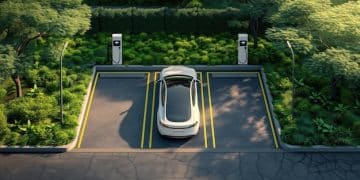Sustainability trends in the automotive industry

Sustainability trends in the automotive industry focus on innovations in recycling, waste reduction, and the rising demand for eco-friendly vehicles, driven by consumer preferences and strict regulations promoting environmental responsibility.
When it comes to the automotive industry, sustainability trends are shaping the future. These changes not only address environmental concerns but also align with shifting consumer expectations. Have you noticed how eco-friendly practices are becoming more prominent in car production?
Emerging technologies in sustainable automotive design
Emerging technologies are revolutionizing sustainable automotive design. Automakers are increasingly focused on reducing their carbon footprint while enhancing vehicle performance. This shift not only benefits the planet but also appeals to eco-conscious consumers.
Innovative Materials
One of the key advancements in sustainable automotive design is the use of innovative materials. Manufacturers are exploring alternatives to traditional materials to create lighter, stronger, and more eco-friendly vehicles.
- Biodegradable composites: These materials break down naturally, reducing environmental impact.
- Recycled metals: Using recycled aluminum and steel helps decrease energy use and resource extraction.
- Natural fibers: Materials like hemp and flax offer strong, lightweight options for interiors and components.
Another exciting area of development is the integration of smart technology in vehicles. Smart technology plays a vital role in enhancing fuel efficiency and minimizing waste. For example, advanced sensors can monitor driving habits, adjusting vehicle performance in real-time to improve fuel economy.
Electric and Hybrid Vehicles
The rise of electric and hybrid vehicles is a defining trend in sustainable automotive design. These vehicles operate on alternative energy sources, reducing greenhouse gas emissions. With continuous improvements in battery technology, electric vehicles are becoming more efficient and affordable.
Additionally, hybrid models that combine traditional engines with electric motors are gaining popularity, offering the best of both worlds. This trend not only addresses environmental challenges but also aligns with evolving consumer preferences for more sustainable transportation options.
3D Printing
Finally, 3D printing is transforming the way automotive parts are manufactured. This technology allows for on-demand production, significantly reducing waste. Manufacturers can create complex components faster and at a lower cost, promoting sustainability throughout the supply chain.
Overall, these emerging technologies demonstrate a clear commitment to sustainability in the automotive industry. By harnessing innovative materials, smart technology, and advanced manufacturing techniques, automakers are paving the way for a greener, more sustainable future on the road.
The impact of electric vehicles on sustainability
The impact of electric vehicles on sustainability is profound and far-reaching. These vehicles are not just a trend; they represent a significant shift in how we think about transportation and its effects on the environment. As more people choose electric cars, the benefits for our planet become clearer.
Reduction in Greenhouse Gas Emissions
One of the most notable impacts of electric vehicles is their potential to reduce greenhouse gas emissions. Traditional gasoline-powered cars contribute significantly to air pollution and climate change.
- Lower emissions: Electric vehicles produce zero tailpipe emissions, which helps improve air quality.
- Renewable energy integration: When charged with renewable energy sources, the emissions associated with electric vehicles decrease even further.
- Efficiency: Electric motors are more efficient than internal combustion engines, leading to less energy wasted during operation.
Moreover, the adoption of electric vehicles can encourage the development of renewable energy infrastructure. As demand for charging stations increases, cities and companies are investing more in solar and wind energy. This trend further supports the shift towards a cleaner energy future.
Economic Benefits
Electric vehicles also contribute to sustainability through economic measures. While the initial cost may be higher, the long-term savings can be significant. By reducing dependency on fossil fuels, consumers save money on fuel and maintenance.
Additionally, jobs in renewable energy and electric vehicle manufacturing are on the rise, fostering economic growth. Communities can benefit from cleaner air and a healthier environment, which contributes to improved public health outcomes.
As electric vehicle technology evolves, we can expect further improvements in battery efficiency, charging speed, and vehicle range. These advancements will make electric vehicles an even more attractive option for consumers.
Local and Global Impact
The impact of electric vehicles extends beyond individual benefits. On a larger scale, widespread adoption can reduce reliance on imported oil, enhancing energy security and stabilizing energy prices. This shift not only supports local economies but also has ripple effects around the world.
In conclusion, electric vehicles are a vital part of the transition towards a sustainable automotive future. By lowering emissions, promoting economic growth, and encouraging renewable energy use, they pave the way for a cleaner planet.
Regulations driving sustainability in the auto sector

Regulations play a crucial role in driving sustainability in the auto sector. These rules and guidelines encourage manufacturers to adopt eco-friendly practices and develop cleaner technologies. As awareness of climate change grows, governments worldwide are implementing laws that push for greener transportation solutions.
Emissions Standards
One of the primary regulations influencing sustainability is the establishment of strict emissions standards. These rules limit the amount of greenhouse gases that vehicles can emit, which significantly affects automaker practices.
- Fleet average emissions: Manufacturers must meet specific targets across their entire fleet, prompting them to innovate.
- Testing procedures: Regular testing ensures compliance with emissions regulations, holding companies accountable.
- Incentives for low-emission vehicles: Tax breaks and other benefits encourage the production of cleaner cars.
These standards not only help reduce air pollution but also push automakers to invest in research and development. As car manufacturers work to meet these regulations, they often discover new technologies that further improve sustainability.
Fuel Economy Regulations
In addition to emissions standards, fuel economy regulations significantly impact the auto industry. These guidelines require manufacturers to produce vehicles that are more fuel-efficient, thus reducing overall fuel consumption and associated emissions.
By enhancing fuel economy, these regulations not only help to protect the environment but also save drivers money at the pump. Innovations such as hybrid and electric vehicles arise from the need to comply with these standards, transforming the automotive landscape.
Moreover, governments are starting to invest in infrastructure that supports sustainable practices. This includes building electric vehicle charging networks and promoting public transportation options. For example, cities are increasingly encouraging ridesharing and carpooling programs to reduce individual car usage.
Global Agreements
On a broader scale, international agreements, like the Paris Agreement, also influence automotive regulations. Countries commit to reducing their greenhouse gas emissions, which encourages legislative actions within their borders. These global efforts emphasize the importance of transitioning to sustainable transportation methods.
As more countries adopt similar regulations, automakers will need to adapt to a diverse set of rules. This creates both challenges and opportunities in developing sustainable vehicles that appeal to a global market.
In summary, regulations are integral in shaping a sustainable future for the auto sector. By enforcing emissions standards, fuel economy guidelines, and international agreements, governments are steering the industry towards more responsible practices.
Consumer preferences for eco-friendly vehicles
Consumer preferences for eco-friendly vehicles are rapidly evolving as people become more aware of environmental issues. Many buyers are actively seeking cars that minimize their carbon footprint while still providing excellent performance and comfort. This shift in preference is reshaping the automotive market.
Increasing Demand for Electric Vehicles
One noticeable trend is the increasing demand for electric vehicles (EVs). Consumers are more interested in buying EVs due to their lower emissions and operational costs. Many people appreciate the idea of driving a vehicle that is both stylish and sustainable.
- Cost savings: EVs typically cost less to operate than traditional gas-powered cars.
- Government incentives: Many regions offer tax credits or rebates for purchasing electric vehicles.
- Technological advancements: Improvements in battery technology have increased driving ranges.
Additionally, hybrids are also gaining popularity. These vehicles combine an internal combustion engine with an electric motor, providing flexible options for consumers. Many buyers see hybrids as a stepping stone toward full electrification.
Desire for Sustainable Brands
Consumers are also drawn to brands that prioritize sustainability in their manufacturing processes. Companies that use recycled materials or sustainable practices in vehicle production often attract buyers who value environmental responsibility. This preference is significant, as consumers want to support brands aligned with their values.
Social media and reviews play a key role in shaping consumer choices. Positive word-of-mouth regarding a company’s sustainability initiatives can drive more customers to choose eco-friendly vehicles. Moreover, many buyers are researching brands and their environmental policies before making a decision.
Challenges in Adoption
Despite the growing interest in eco-friendly vehicles, some challenges remain. Range anxiety—the fear of running out of battery charge without access to charging stations—still affects many potential EV buyers. Addressing this concern through improved infrastructure and network of charging stations is essential.
Price can also be a barrier. Although prices for electric and hybrid vehicles are decreasing, they can still be higher than traditional cars. However, as technology advances and economies of scale come into play, prices are likely to drop further.
As consumer preferences continue to shift towards eco-friendly vehicles, automakers must adapt their strategies to meet these demands. By investing in clean technologies and sustainable practices, they can remain competitive in an increasingly green market.
Innovations in recycling and waste reduction
Innovations in recycling and waste reduction are transforming the automotive industry. As manufacturers work towards sustainability, they are adopting new technologies and practices that minimize waste and promote the reuse of materials. These changes not only help the environment but also make economic sense.
Use of Recycled Materials
Many automakers are now using recycled materials in their production processes. This reduces the need for virgin resources and decreases overall waste. For instance, plastics from old vehicles can be reprocessed and used in new models.
- Recycled aluminum: Automakers are using recycled aluminum for car parts, which requires less energy compared to producing new aluminum.
- Textiles from recycled fibers: Interior components are increasingly made from recycled fabrics, reducing textile waste.
- Glass recycling: Glass from old vehicles is being recycled to produce new automotive glass, helping to conserve resources.
This shift towards a circular economy is vital for reducing the automotive industry’s environmental footprint. By reusing materials, companies can decrease emissions associated with production and material extraction.
Advanced Waste Management Techniques
Beyond recycling, advanced waste management techniques are being implemented to minimize waste during manufacturing. For example, companies are adopting lean manufacturing practices that emphasize efficiency.
By analyzing production processes, manufacturers can identify areas to reduce waste. This includes optimizing supply chains to limit excess inventory, which can lead to waste. Additionally, many companies are now incorporating more efficient methods of production, such as 3D printing, which generates less waste compared to traditional manufacturing.
Innovative Waste Reduction Strategies
Another important aspect of waste reduction is the implementation of comprehensive waste sorting practices. Automakers are training employees to properly sort materials for recycling and composting. This not only increases recycling rates but also fosters a culture of sustainability within the workplace.
Several automotive companies are collaborating with environmental organizations to develop innovative programs aimed at reducing waste. These partnerships may involve research on new materials or community initiatives that promote recycling and sustainable practices.
As the automotive industry moves towards sustainability, the focus on innovations in recycling and waste reduction will be crucial. By adopting these new strategies and technologies, manufacturers can play a significant role in protecting the environment while also benefiting economically.
FAQ – Frequently Asked Questions about Sustainability in the Automotive Industry
What are the main benefits of using recycled materials in automotive manufacturing?
Using recycled materials reduces the need for virgin resources, decreases waste, and often requires less energy to process, leading to lower greenhouse gas emissions.
How do consumer preferences impact the demand for eco-friendly vehicles?
As consumers become more environmentally conscious, they actively seek eco-friendly vehicles, leading automakers to focus on developing sustainable options, such as electric and hybrid cars.
What role do regulations play in promoting sustainability in the automotive sector?
Regulations set emissions standards and fuel economy requirements that drive automakers to innovate and implement sustainable practices throughout their production processes.
What are some common waste reduction techniques used by automotive manufacturers?
Common techniques include lean manufacturing, recycling of manufacturing waste, and implementing efficient supply chain management to minimize excess inventory and waste.





